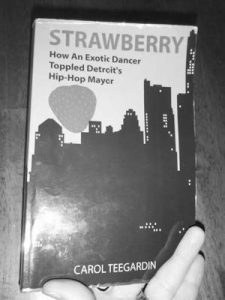Detroit Drama: from life, to book, to stage
By Nicholas Ray
Photos by Bernie LaFramboise
I met Carol Teegardin at the Rustbelt Market on 9 Mile this past weekend at the annual Funky Ferndale Art Fair to discuss the play she has written, “Strawberry: What Party.” She’d written a book of the same title, published three years rior, chronicling the tragic and mysterious murder of Tamara Greene in 2003. The murder eventually became a major news story, and led to investigations that brought down a political dynasty and changed the course of Detroit history.
“Strawberry: What Party” tells the story of a party that allegedly happened the year before at the Manoogian  Mansion, the City-owned residence of the mayor of Detroit at the time, Kwame Kilpatrick. According to press accounts, Ms. Greene was one of several women working as exotic dancers at the private party hosted by the mayor, with several of the mayor’s friends in the house. And, we’d never ave likely heard about it except for the mayor’s wife allegedly assaulting Ms. Greene and the other exotic dancers at that party.
Mansion, the City-owned residence of the mayor of Detroit at the time, Kwame Kilpatrick. According to press accounts, Ms. Greene was one of several women working as exotic dancers at the private party hosted by the mayor, with several of the mayor’s friends in the house. And, we’d never ave likely heard about it except for the mayor’s wife allegedly assaulting Ms. Greene and the other exotic dancers at that party.
There are few unsolved murders in the history or Detroit more infamous or pivotal as the tragic death of Tamara Greene in the spring of 2003. The 27-year-old exotic dancer and entrepreneur was shot to death by a drive-by shooter that April and the case remains unsolved to this day. Ms. Teegardin spent years as a successful columnist for The Detroit News, but she remained committed to her goal of being an investigative journalist. “I’d always wanted to do the Bernstein/Woodward thing.”
And in Strawberry, she has certainly achieved just that, working as hard in retirement as she ever did for the Detroit News. Over a five-year period, she interviewed dozens of primary sources involved in all areas of the case, many of them more than once. She spoke with friends and family of Ms. Greene, her church pastor, and even attended a number of family events.
When it comes to identifying who actually murdered Tamara Greene, Teegardin doesn’t come to a definite conclusion. This might disappoint some readers, especially those who have their own theories (and there are plenty of those). What she does, however, is infinitely more nuanced and arguably far more interesting. Ms. Teegardin walks her readers through the intricate twists and turns, the seemingly contradicting evidence of the case, and describes how Greene’s murder became such a huge story, and how it led to the series of circumstances that would eventually bring down the Kilpatrick administration and end a political dynasty in Detroit.
No one should be fooled by Ms. Teegardin’s small stature. The book was a monstrous effort on her part, requiring an immense amount of commitment that seems so typical of “old-school journalists” like Teegardin. Not only did she edit the book herself, she also self-financed its publication in a number of unorthodox ways.
“It was the most fun thing I’ve ever done,” she smiled and nodded. “It was a dream come true.”
The Tamara Greene and Kwame Kilpratrick story never seems to go away completely. In fact, Teegardin sold every book she had on the day I met her. Maybe her dream is coming true.
The stage production will debut at Marlene Boll Theatre on January 20, 2017, and will be about 90 minutes in duration. The production will be directed by award-winning director Mary Bremer-Beer.



